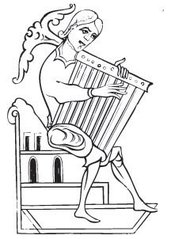Musical instrument
|
|
The academic study of musical instruments is called organology.
Instruments are often divided by the way in which they generate sound:
- Wind instruments generate a sound when a column of air is made to vibrate inside them. The frequency of the wave generated is related to the length of the column of air and the shape of the instrument, while the tone quality of the sound generated is affected by the construction of the instrument and method of tone production. The group is typically subdivided into Brass and Woodwind instruments.
- Percussion instruments create sound, with or without pitch, when struck. The shape and material of the part of the instrument to be struck and the shape of the resonating cavity, if any, determine the sound of the instrument.
- String instruments generate a sound when the string is plucked, strummed, slapped, etc. The frequency of the wave generated (and therefore the note produced) usually depends on the length of the vibrating portion of the string, its mass, the tension of each string and the point at which the string is excited; the tone quality varies with the construction of the resonating cavity.
- Voice, that is, the human voice, is an instrument in its own right. A singer generates sounds when airflow from the lungs sets the vocal cords into oscillation. The fundamental frequency is controlled by the tension of the vocal cords and the tone quality by the formation of the vocal tract; a wide range of sounds can be created.
- Electronic instruments generate sound through electronic means. They often mimic other instruments in their design, particularly keyboards.
- Keyboard instruments are any instruments that are played with a musical keyboard. Every key generates one or more sounds; most keyboard instruments have extra means (pedals for a piano, stops for an organ) to manipulate these sounds. They may produce sound by wind (organ), vibrating strings either hammered (piano) or plucked (harpsichord), by electronic means (synthesizer) or in some other way. Sometimes, instruments that do not usually have a keyboard, such as the glockenspiel, are fitted with one.
Many alternate divisions and further subdivisions of instruments exist. To learn about a specific instrument, consult the list of musical instruments or List of archaic musical instruments.
All classes of instruments save the electronic are mentioned in ancient sources, such as Egyptian inscriptions and the Bible, and probably predate recorded history. The human body, generating both vocal and percussive sounds, may have been the first instrument, or, perhaps, found percussion instruments such as stones and hollow logs. Nine-thousand-year-old bone flutes or recorders have been found in Chinese archeological sites.
See also
*Extended technique- Folk instrument - a description and a list
- Music lessons
- Orchestra
- Vocal and instrumental pitch ranges



